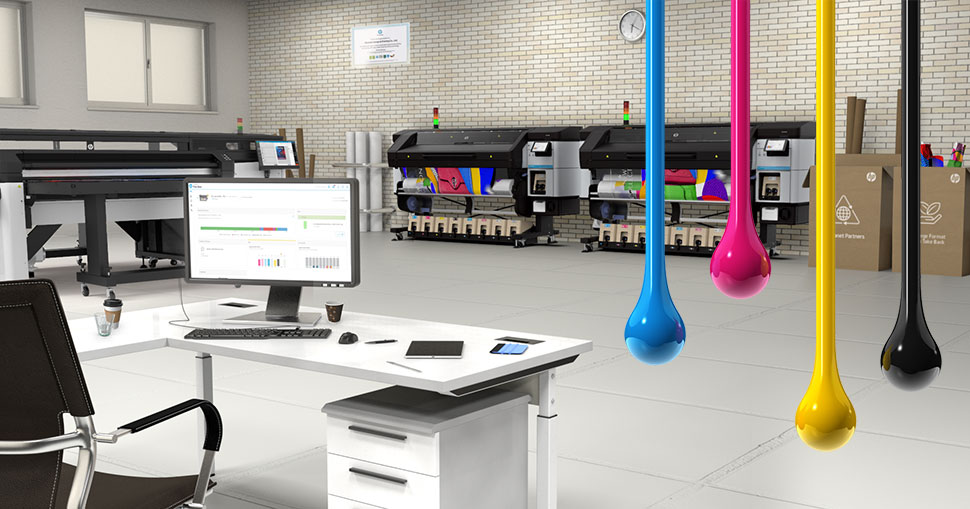Thom Brown, HP's Chief Inkologist, discusses HP Latex: what it is; how it works; and what are the key benefits.
HP has refined its Latex technology over the last decade to meet the demands of Print Service Providers (PSPs) which, according to a great deal of research with both existing HP users and other non-HP customers, boils down to turning around sellable, consistent output quickly. This doesn't just mean fast printer speeds with no failures on standard substrates; it also means producing everything the end-user market wants. Environmental consciousness and material diversity are the boxes being ticked by print buyers more and more often - which is where HP Latex comes in. But what is it, how does it work and what are the benefits for wide-format print and signage businesses?
The science of HP Latex
HP Latex is a water-based ink technology, meaning up to 70% of the ink formula is water. The latest water-based HP Latex inks are designed to avoid the hazards associated with other inks. This ink formula is combined with wetting agents and humectants needed for printhead reliability (which, incidentally, your HP home printer also uses) to produce a liquid ink vehicle that carries latex polymer and pigment particles to and through the printer's printheads onto the substrate. Radiant heat and forced airflow evaporate the liquid and set the latex, binding the pigments and substrate together to leave a durable image on the print media surface. Prints are ready to use, even laminate, immediately.
Environmental and health credentials
HP is committed to making a positive, enduring impact by protecting the planet, supporting our people, and strengthening communities where we live, work, and do business. Take for example the water-based formulation of HP Latex; this technology transformed the industry years ago, and every new generation has continued to push further.
Furthermore, HP has launched the world's first laptop manufactured with high-quality recycled plastics-material saved from the ocean courtesy of the company's $2 million plastic washing line, which was opened in Haiti in 2020.
HP Latex is designed for sustainable impact and is further backed by numerous eco-labels and certifications; we work together with industry-wide associations to make sure we offer the best for our customers.
The most recent HP Latex inks are UL ECOLOGO certified, meeting stringent health and environmental criteria, including toy safety requirements.
All HP Latex Inks also achieve GREENGUARD GOLD certification at the unrestricted level. This certification proves that a product has very low emissions - even at full room coverage - and low enough to be used in sensitive environments such as schools and hospitals. This is a benefit for PSPs wishing to sell to these markets and for their employees too: HP Latex printers have no special ventilation requirements, and HP Latex ink produces odourless prints. This often proves to be a challenge for other ink technologies.
Thanks to the water-based formulation, the latest HP Latex inks makes these products an ideal, no hazard label alternative to UV, UV Gel, Solvent, and Eco-Solvent inks.
One-stop shop
Businesses that offer a wide range of products can potentially reach more customers - and more time- and cost-effectively - if they are able to do so using the same equipment. Latex inks are suitable for direct-to-substrate printing onto a lengthy list of materials, with many media certified for use by manufacturers and suppliers around the world. Signage applications include retail displays, outdoor signage, window graphics, vehicle wraps, event and exhibition displays, soft signage, stickers and decals, clothing and backlits.
In the decor market Latex is also used successfully for fade-resistant window blinds, canvases, wall coverings, PVC flooring and textiles including synthetic leather. This ingrained compatibility also enables PSPs to use alternative substrates with certain environmental attributes into their ranges: reclaimed wood, FSC-certified sustainable papers, PVC-free materials and textiles, for instance. The online HP Media Locator can help identify eco-conscious media to best meet any PSP's requirements.
Finally, HP has now expanded the versatility and opportunity for its printers even more with the introduction of white HP Latex ink for use in its systems.
Quick turnaround
The HP Latex R2000 Plus, the largest of HP's new Latex series printers, can print at speeds of up to 43sqm/hr, or 14 boards, in indoor (100%) production mode and 86sqm/hr, or 28 boards, in outdoor (70%) mode. However, turnaround is not just about how fast this stage is completed; HP printers' heating units warm up quickly and dry prints as soon as they are printed, with air recirculated to boost operating efficiency.
Cleaning is automated and daily maintenance is minimised, while HP-branded media and generic media profiles are pre-loaded in the software to cut the time operators spend on these processes too. Complementary cutting systems have also been developed to work with Latex printers in an intuitive solution.
While arguably the most important part of an HP Latex set-up is its water-based ink, it is critical that every part of the solution must work together to achieve the results, versatility and environmental credentials demanded by customers.
Sustainability has been important for HP since its foundation and it is recognised as one of the world's most sustainable companies, so when you partner with HP you share in that purpose. The company's latest goals continue to drive towards a net zero carbon, circular economy, and net zero deforestation, with the ambition to become the world's most sustainable and just technology company.
For details on the sustainable design of the latest HP Latex printers, please click here





